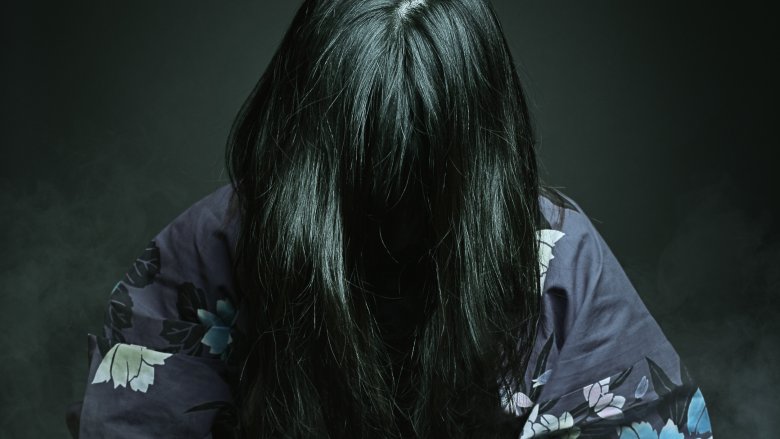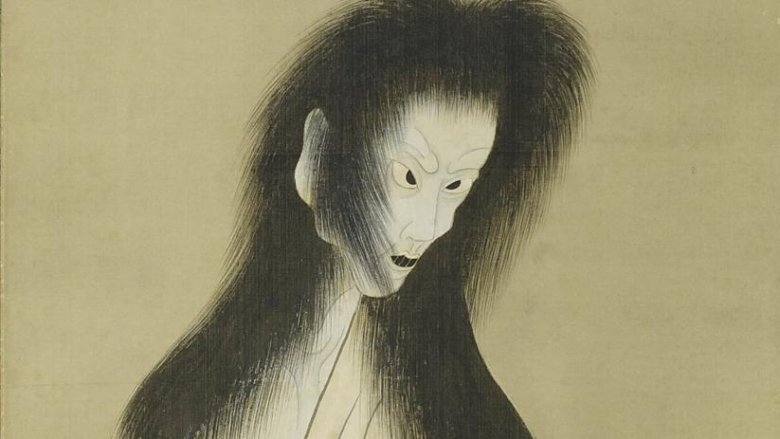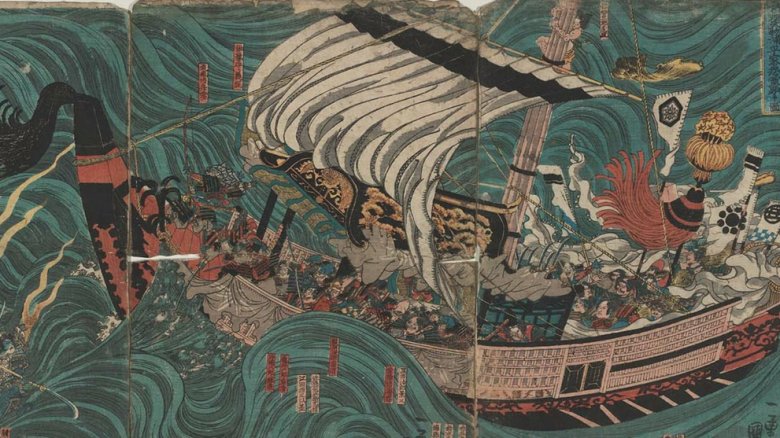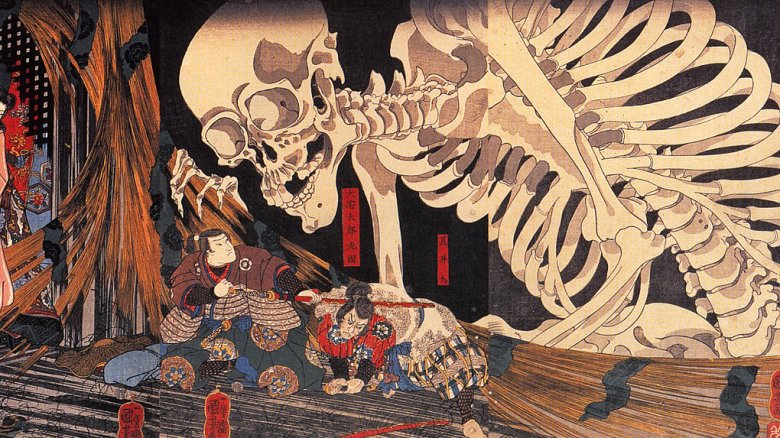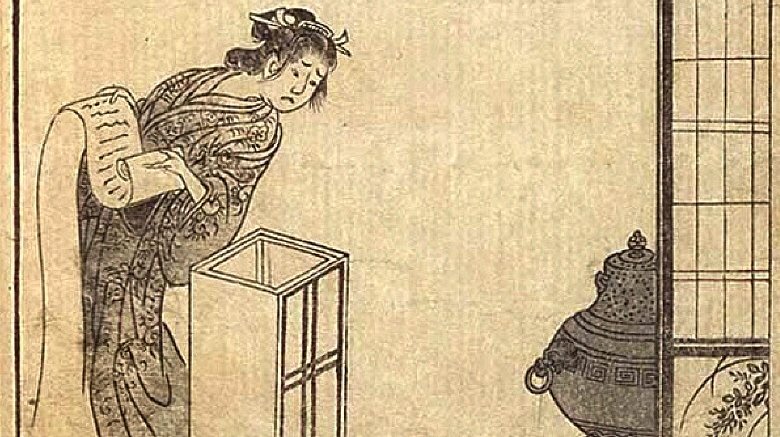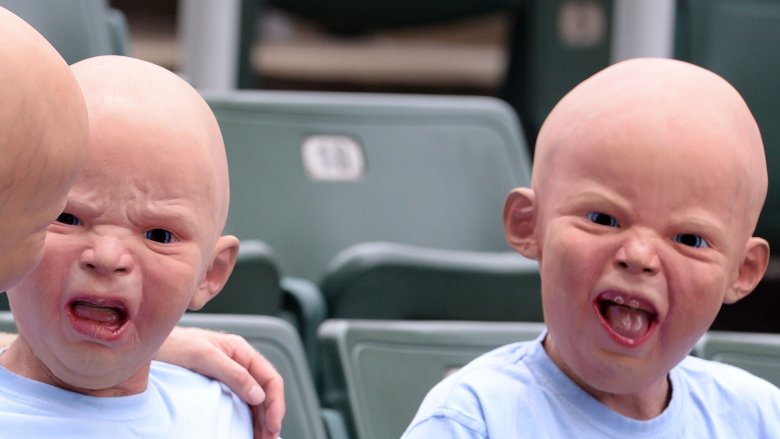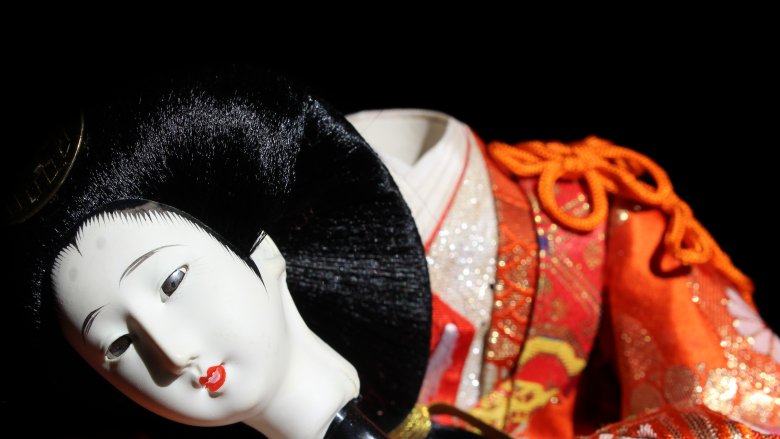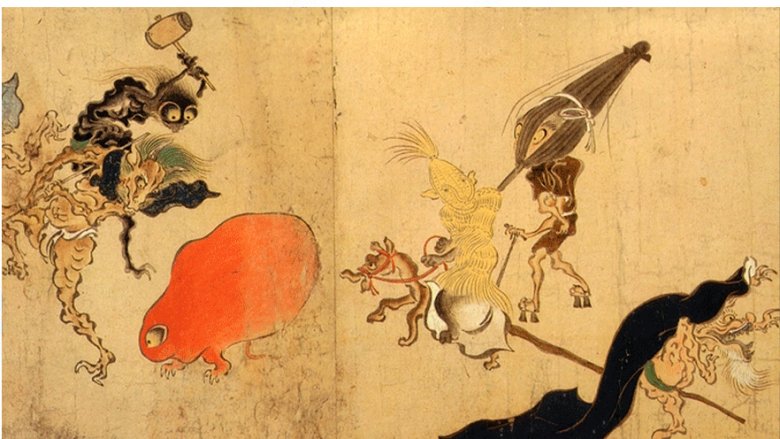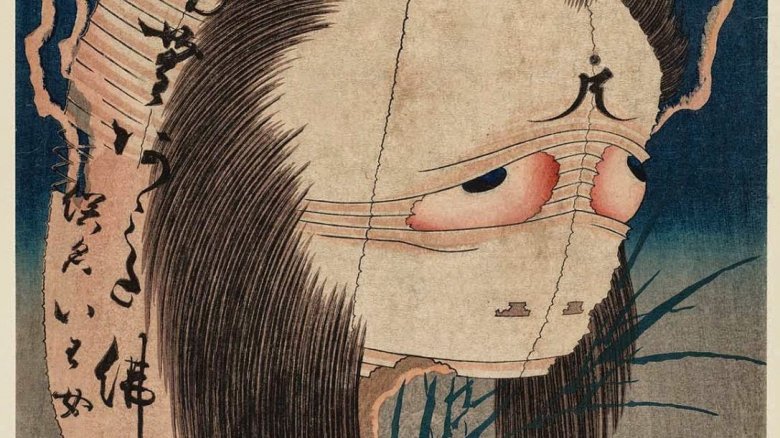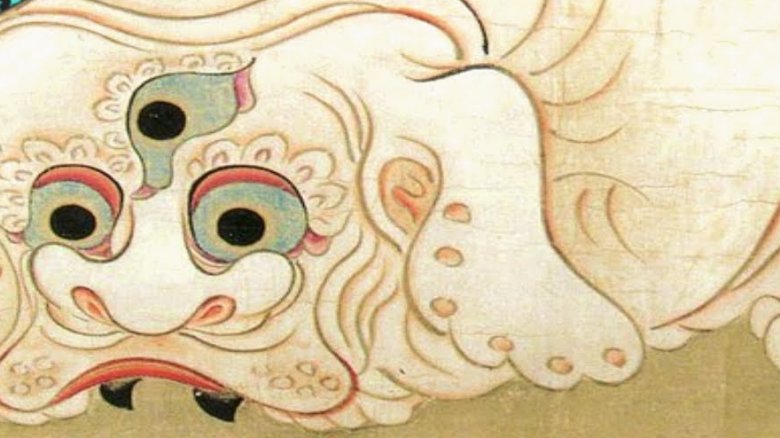Terrifying Japanese Ghosts That Will Haunt Your Dreams
If you spend enough time reading ghost stories or watching haunted house movies, there's a good chance you might hit a spot where you feel like you've seen it all. A floating candelabra? Yawn. The revenant of a long-dead governess unjustly killed who yearns for proper burial? Please. Focused, non-terminal repeating phantasm? Class-five full-roaming vapor? No thanks.
Fortunately for you, jaded ghost enthusiast, there's literally a whole country full of the wildest, absolutely bananapants ghost, goblins, creeps, and spookums ready for you to discover them. Japan has been developing the art of the weird-as-hell ghost story since before the Americas were even a twinkle in colonial Europeans' eyes. And in that time, they've gotten really good at it.
While the Japanese technically break down their spooky beasts into such categories as yurei, yokai, and obake, for the sake of simplicity, we're just going to call them all ghosts. What follows is just the tiniest of samplings of the weird, wild world of Japanese ghosts and spirits. Take a look, maybe you'll find something you like. Maybe you'll find something that will haunt you forever.
Aka manto
As Atlas Obscura helpfully points out, Japan has no shortage of bathroom ghosts, including a little girl ghost who is basically Bloody Mary but from a bathroom stall instead of a mirror, and a long-tongued goblin who just wants to lick the grime ring in your bathtub, which is probably also a subsection of Craigslist, come to think of it.
But perhaps the freakiest Japanese bathroom ghost is Aka manto, which means "red cloak," though this bathroom boy is also known by names such as aoi manto, akai kami, akai hanten, akai chanchanko, and akai te, which all have something to do with the colors red and blue and paper or cloaks or similar. The premise is this: when you find yourself having to go so bad that you'll even go to the school's haunted bathroom, you might find yourself having run out of toilet paper. At this time, Aka manto will appear and offer you red paper or blue paper. If you pick red paper, Aka manto will flay your back, making it appear you're wearing a red cloak like his. If you pick blue paper, he will suffocate you until you turn blue. Like a blue cloak, get it? Victims who try to get clever by picking another color suffer rough fates as well. Picking yellow paper, for example, might get you drowned face down in pee.
Strangely enough, the story of Aka manto was adapted on an episode of Scream Queens, of all things.
Buruburu
Have you ever seen The Tingler? It's a cheesy but ultimately kind of brilliant horror movie from 1959 starring Vincent Price about a normally invisible creature that lives in every human's spine that feeds off their fear and will cause them to die of fright if they don't relieve the tension by screaming. It's the creature that causes that "spine-tingling" sensation, hence the movie's title.
Well, it turns out the Japanese have a similar creature, only theirs is a terrifying ghost and not a cheap-looking rubber centipede. The buruburu is a ghost that feeds on fear, and gets its name from the sound you make when you shiver. (Like "brrrr," get it?) A buruburu is created whenever someone acts like a coward, such as running away from battle or ordering mild buffalo wings.
Once born, the buruburu possesses the coward by clinging to the collar of their shirt and lightly tickling the back of their neck (also a service available on Craigslist). This causes a shiver down their spine and goosebumps (or Fear Street if you're a teen), which is all part of the parasitic cycle of the coward-buruburu relationship. You freak out, the buruburu is born, it tickles the back of your neck, you get more afraid, and then the buruburu feeds of the delicious manna that is human fear, which for the buruburu is the most delicious possible food, i.e., the actually hot buffalo wings of ghost food.
Funayurei
Just when you thought it was safe to go back in the water, it turns out it is definitely not at all safe to go back into the water. Because, as it happens, the water is full of ghosts. Also something called an "eel princess." Don't go in the water.
Japanese folklore has a whole category of ghosts called funayurei, which just means "ship ghosts." They are the ghosts of drowned sailors, who, instead of going, "Wow, I would never wish this terrible fate on anyone else," say, "I wish my friends were here. I will seek them out and drown them." The ghost ship of the funayurei will approach an unsuspecting ship first as a misty fog before materializing as a full ship laden with a ghostly crew, who then try to capsize the alive person ship to make them ghosts also. They might cling to the sides of the ship and try to drag it down, or else fill the decks with water using barrels, buckets, and ladles. Or worse, sometimes instead of a ship, it is one giant ghost that will push the ship down. And if you don't get drowned, you might get eaten by giant flesh-eating mermaids. It's not better down where it's wetter.
Just don't let Johnny Depp hear about them, or we'll end up with a sixth Pirates of the Caribbean movie that will be set in Japan and will probably just be, like, mad racist.
Gashadokuro
What could possibly be spookier scarier than spooky, scary skeletons? Nothing, right? It's right there in the name. Obviously the top of the list of spooky scary things is creaky old skeleton bones such as you might find inside your own body if all your flesh was stripped away and you were condemned to battle eternally against those seeking the Golden Fleece. (Second on the spooky scary list is obviously lycanthropic coming-of-age rituals.)
Well, this was a test, and you failed. There is something scarier than skeletons and it is a giant skeleton that will eat your head for funzos. The gashadokuro gets its name from a combination of the word "odokuro" (meaning "giant skeleton") and the onomatopoeia "gachi gachi," which is the sound of rattling bones.
A gashadokuro is formed when the bodies of soldiers killed in battle or those who starved to death are left to rot in the fields. They die with hate in their hearts and this anger — this grudge, if you will — fuels them even past death and the decomposition of their flesh. When all that is left is bones and spite, these angry skeletons merge together like a Voltron of Bad Feelings with the intent to expend their malice upon the living.
And so if you're ever out at night and hear the rattle of dem dryyyy bones, you better hope it's just a normal-sized alive skeleton after you, and not one 30 stories tall that's looking to work out its rage issues by grinding you into a paste.
Ikiryoh
What if you're full of seething hate but not at risk of starving to death or dying in battle? Is it possible that you could also somehow supernaturally enact your hatred upon the living but without having to die first? Could you, in short, be an alive hate ghost?
Great news: yes. You could be an ikiryoh, whose name means "living ghost." An ikiryoh comes into being in those times when you're just ... just so mad that you totally astral-project. You can relate. You're so mad your entire soul comes out of your body as a translucent representation of yourself and seeks the revenge your body so richly desires.
An ikiryoh could also occur as a result of other strong emotions or trauma, such as near-death experiences. Or if you faint hard enough. Or if you get cursed. Maybe if you get cursed at? There's no shortage of reasons why your soul might just slip out of your body like a psychic shart. And the wildest part is that the owner of the soul almost never knows that they have become part ghost. This could lead to all sorts of sitcom-style shenanigans and misunderstandings, like the classic scenario in which you continue to work your spirit-crushing shift at Quizno's and your rage-fueled soul slips away like Peter Pan's shadow to do some murders. You know, just like that one episode of Family Matters where Urkel's soul kills Laura's sister and that's why she wasn't in the later seasons.
Konaki-jiji
There are a number of people, especially young people, who don't care for children. There are likewise a number of people who become uncomfortable around the elderly. Sometimes these are the same people. You know who you are. You might claim it's because they're boring or they smell bad (babies or the elderly), but likely the real source of your fear is the dawning realization of your own mortality.
Fortunately for you, the ever efficient and resourceful Japanese have managed to combine your two great fears into one with the konaki-jiji, a ghostly creature whose name means "old man crying like a baby." The konaki-jiji is the ghost of a baby who was left to die in the woods. Travelers through such woods may hear the cry of a distressed baby coming from the dark of the trees. When they trace the source of the crying sound, they will find a bawling infant lying on the ground. Feeling sorry for this helpless child, they will pick it up and begin to carry it out of the woods. But as they walk, they will notice the baby getting heavier and heavier. Startled by this unnatural occurrence, they will look down at the baby and be shocked to see that the baby has an old man's face! More than normal babies look like old men, presumably. By then it's too late: the ghost baby's weight becomes so great that it crushes them to death. This is a really on-the-nose metaphor about parenthood.
Kubikajiri
You know that expression "I'd lose my head if it wasn't screwed on"? Maybe you can relate. And you know the follow-up expression, "And if I did lose my head, I would definitely go around eating every head that crossed my path"? No? That one's not as familiar? Maybe that's just a saying among the kubikajiri community.
The kubikajiri is a ghost without a head of its own that lurks around graveyards hoping to come across its lost head. Assuming that in life this ghost visited a lot of graveyards, this might be a useful retracing of steps. Any head it comes across, living or dead, that does not turn out to be its own head gets eaten. Eaten by the ghost's neck hole, presumably? Most traditional artwork of the kubikajiri shows it as actually having a head with which to eat other heads, which just feels like pretty sloppy continuity, honestly. "Headless thing that eats heads" is a simple, two-step concept, so to forget fully half of the interesting things about it while drawing it seems pretty lazy. It's like getting assigned to draw the Headless Horseman and then just drawing a regular head-having dude on a horse. You got part of the way there and then forgot what you were doing, guy.
A kubikajiri can also be recognized by its distinctive smell, that of fresh blood. Presumably it smells like fresh blood because it has been ineffectually rubbing severed heads against its neck stump trying to chew with its cervical vertebrae.
Tsukumogami
At this point, you might be thinking, "Okay, this is definitely a wide variety of ghosts and demons that can come from all sorts of origins, so my only recourse is to stay away from all human life and only surround myself with inanimate objects, whose lack of souls means there is no chance at all of them becoming ghosts." Not so fast, Robinson Crusoe. There's some terrible news for you, and it comes in the form of tsukumogami, which more or less means "tool spirits."
The idea in Japanese folklore is that any object sufficiently old will become haunted. If you've ever seen a doll made before, say, the 1980s, this probably makes total instinctual sense to you. A tsukumogami can be basically any object that has reached the age of 100 years, at which point it gains consciousness and self-awareness. Examples of such formerly inanimate objects in folklore include a sandal that grows arms and legs and one giant eye that chants incessantly at night, and a flying roll of cotton cloth that will try to smother you by wrapping up your face.
Generally speaking, tsukumogami are considered to be harmless, if occasionally mischievous pranksters. However, if their owners from when they were inanimate had been wasteful or neglectful, the now-living tools would team up and take revenge upon their sleeping masters. So think carefully about how you treat your water jars or umbrellas if you think they're anywhere close to hitting a hundo.
Bakechochin
One of the best-known examples of a tsukumogami is the bakechochin or chochin-obake, both of which mean "paper lantern ghost." Guess what it is. Stumped? Studious research reveals that it's a paper lantern that has turned into a ghost.
When your chochin, the classic Japanese paper lantern, hits its 100th birthday, its paper shell will split along one of its wooden ribs, creating a wide, yawning mouth, out of which will pour a long, lascivious tongue. The upper half of the lantern will sprout a giant single eye (though two eyes are known to occur) and sometimes arms and legs. And then this lantern just goes buck wild. To be fair, if you had been a motionless lantern for a century, you'd probably also be ready to party as soon as you had the power to grow eyes and a tongue. What more do you need, really?
For the most part, the chochin-obake is a mostly harmless prankster, like most tsukumogami, and just enjoys popping out and scaring unwitting visitors with its freaky ghost tongue. However, in some versions of the story, the chochin-obake becomes home to the spirit of someone who has died with hate in their heart and is condemned to haunt the Earth forever. If you happen across one of these lanterns and light it, a vengeful ghost might pop out and ghost you to death. Before lighting a lantern in Japan, ask if it's the nice tongue kind or the "hateful revenant" kind, just to be safe.
Nurikabe
The nurikabe, whose name means "painted wall," is a spook encountered by those traveling late at night, especially in dark streets and alleys. It's an invisible wall that will block your path no matter which way you try to go. If you juke left, it will stretch left. If you feint right, it will stretch right. It can stretch for infinity miles in every direction, so you don't really have a chance. You can't climb over it, and you can't knock it down. It just can't be done.
Even though the nurikabe is supposed to be an invisible wall, artists have still managed to develop a traditional way of depicting it: as a gray, two-footed, flat-faced monster that kind of looks like a cross between a saggy fat guy and that one dog you learned to draw in elementary school by drawing six circles first.
It turns out there is a solution to the nurikabe puzzle, however: if you hit it with a stick near the ground, it will vanish and you can go on your way. This solution makes sense if you agree with the theory that nurikabe are just tanuki stretching out their magical scrotums into a giant wall. At any rate, nurikabe make for a super convenient excuse for being late. "Sorry I missed your birthday party. A giant fat dog man or possibly an invisible raccoon scrotum was blocking my way. I think we've all been there in this, the totally normal country of Japan."
